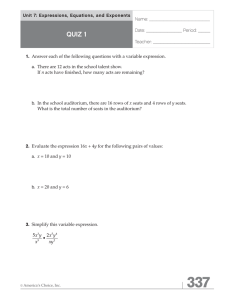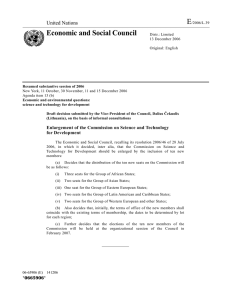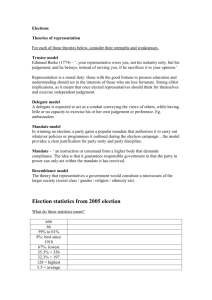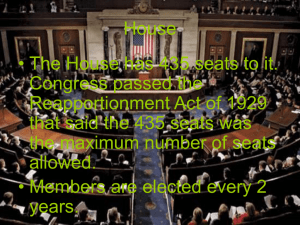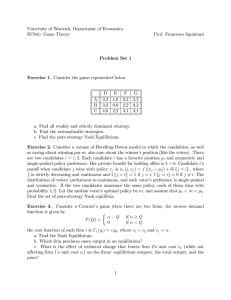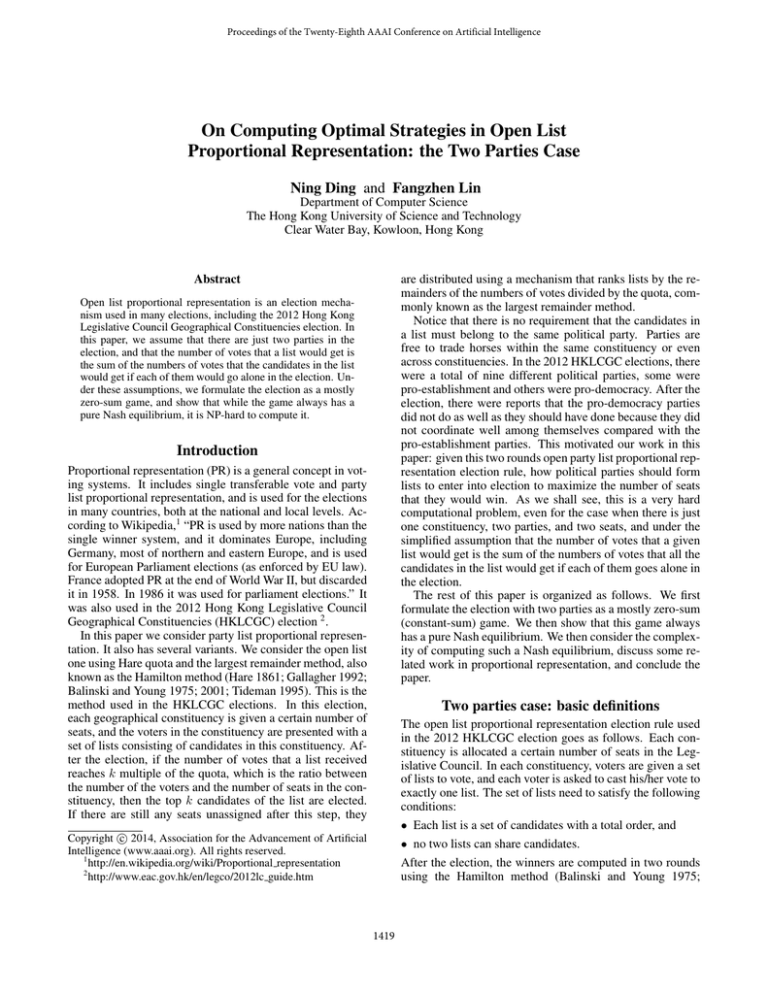
Proceedings of the Twenty-Eighth AAAI Conference on Artificial Intelligence
On Computing Optimal Strategies in Open List
Proportional Representation: the Two Parties Case
Ning Ding and Fangzhen Lin
Department of Computer Science
The Hong Kong University of Science and Technology
Clear Water Bay, Kowloon, Hong Kong
Abstract
are distributed using a mechanism that ranks lists by the remainders of the numbers of votes divided by the quota, commonly known as the largest remainder method.
Notice that there is no requirement that the candidates in
a list must belong to the same political party. Parties are
free to trade horses within the same constituency or even
across constituencies. In the 2012 HKLCGC elections, there
were a total of nine different political parties, some were
pro-establishment and others were pro-democracy. After the
election, there were reports that the pro-democracy parties
did not do as well as they should have done because they did
not coordinate well among themselves compared with the
pro-establishment parties. This motivated our work in this
paper: given this two rounds open party list proportional representation election rule, how political parties should form
lists to enter into election to maximize the number of seats
that they would win. As we shall see, this is a very hard
computational problem, even for the case when there is just
one constituency, two parties, and two seats, and under the
simplified assumption that the number of votes that a given
list would get is the sum of the numbers of votes that all the
candidates in the list would get if each of them goes alone in
the election.
The rest of this paper is organized as follows. We first
formulate the election with two parties as a mostly zero-sum
(constant-sum) game. We then show that this game always
has a pure Nash equilibrium. We then consider the complexity of computing such a Nash equilibrium, discuss some related work in proportional representation, and conclude the
paper.
Open list proportional representation is an election mechanism used in many elections, including the 2012 Hong Kong
Legislative Council Geographical Constituencies election. In
this paper, we assume that there are just two parties in the
election, and that the number of votes that a list would get is
the sum of the numbers of votes that the candidates in the list
would get if each of them would go alone in the election. Under these assumptions, we formulate the election as a mostly
zero-sum game, and show that while the game always has a
pure Nash equilibrium, it is NP-hard to compute it.
Introduction
Proportional representation (PR) is a general concept in voting systems. It includes single transferable vote and party
list proportional representation, and is used for the elections
in many countries, both at the national and local levels. According to Wikipedia,1 “PR is used by more nations than the
single winner system, and it dominates Europe, including
Germany, most of northern and eastern Europe, and is used
for European Parliament elections (as enforced by EU law).
France adopted PR at the end of World War II, but discarded
it in 1958. In 1986 it was used for parliament elections.” It
was also used in the 2012 Hong Kong Legislative Council
Geographical Constituencies (HKLCGC) election 2 .
In this paper we consider party list proportional representation. It also has several variants. We consider the open list
one using Hare quota and the largest remainder method, also
known as the Hamilton method (Hare 1861; Gallagher 1992;
Balinski and Young 1975; 2001; Tideman 1995). This is the
method used in the HKLCGC elections. In this election,
each geographical constituency is given a certain number of
seats, and the voters in the constituency are presented with a
set of lists consisting of candidates in this constituency. After the election, if the number of votes that a list received
reaches k multiple of the quota, which is the ratio between
the number of the voters and the number of seats in the constituency, then the top k candidates of the list are elected.
If there are still any seats unassigned after this step, they
Two parties case: basic definitions
The open list proportional representation election rule used
in the 2012 HKLCGC election goes as follows. Each constituency is allocated a certain number of seats in the Legislative Council. In each constituency, voters are given a set
of lists to vote, and each voter is asked to cast his/her vote to
exactly one list. The set of lists need to satisfy the following
conditions:
• Each list is a set of candidates with a total order, and
• no two lists can share candidates.
After the election, the winners are computed in two rounds
using the Hamilton method (Balinski and Young 1975;
c 2014, Association for the Advancement of Artificial
Copyright Intelligence (www.aaai.org). All rights reserved.
1
http://en.wikipedia.org/wiki/Proportional representation
2
http://www.eac.gov.hk/en/legco/2012lc guide.htm
1419
2001) as follows. Suppose the constituency has K seats,
and V voters. Then Q = V /K is called the quota of the
constituency. In social choice literature, this quota is often
called the Hare quota (see, e.g. (Hare 1861)), in contrast
to other notions of quotas such as the Droop quota (Droop
1881; Lundell and Hill 2007). In the first round, if a list L receives at least M ∗ Q votes, then the top M candidates from
L are elected, assuming that L has at least M candidates. If
L has less than M candidates, then all candidates in L are
elected, and the list is eliminated. After this, any remaining
seats are distributed in the second round using the largest
remainder method as follows: the remaining K1 seats are
given to the K1 lists that still have any candidates left and
have the largest remainders of the vote counts divided by the
quota, with ties broken by lottery.
For example, suppose K = 5 (5 seats) and V = 100 (100
voters). Then the quota is Q = 100/5 = 20. Suppose there
are four lists: l1 = [a, b, c], l2 = [d], l3 = [e, f ], and l4 =
[g], and they received 50, 30, 10, and 10 votes, respectively.
Then in the first round, the top two candidates from l1 , a
and b, and the candidate from l2 are declared winners. This
leaves 2 seats to be filled in the second round. The list l2
is discarded now as it has no more candidates left. For the
remaining lists l1 , l3 , and l4 , the remainders of their vote
counts over the quota are all 10. A lottery is then held to
give the two seats to two of the lists.
Notice that it is possible for a list that receives no vote
to be a winner. For instance, suppose there are two seats,
and two lists: one that has a single candidate and gets all the
votes, and the other that receives no vote. Then in the first
round, the candidate in the first list is elected. The remaining
one seat will be given to the top candidate in the second list
in the second round. It is also possible that not all seats can
be allocated. For instance, suppose there are three seats, and
again two lists: one that has one candidate and gets all the
votes, and the other that includes all of the other candidates
and receives no vote. Then again, the candidate in the first
list is elected, and the top candidate in the second list is also
elected in the second round. These two are the only winners. However, these are all extreme cases that are unlikely
to occur in practice.
Notice also that according to the election rule, there is no
requirement as who can form a list. However, it is clear that
the system is designed with political parties in mind, and the
candidates in a list should come from either the same party
or the parties that are willing to form an alliance. Thus to
make the problem interesting, we assume that each candidate is affiliated with a certain party, and the problem is how
a party should form lists to enter into election so as to maximize the number of seats that will be won by the party as a
whole. In other words, the game is not about which candidate would win, but which party would win the most number
of seats.
In general, when there are multiple parties participating
in elections in multiple constituencies, there are issues such
as whether any group of parties should form an alliance, and
once an alliance is formed, how to put forward candidate
lists. In this paper, we consider only when there are two parties. In this case, the two parties are competing against each
other very much like in a zero-sum game. The only issue is
then how each party should form lists so as to maximize the
number of seats that it would win. Furthermore, maximizing the number of seats won in all constituencies amounts to
maximizing the number of seats won in each constituency.
Thus for the two parties case, we can assume there is just
one constituency.
Obviously, to decide how to form lists from its pool of
candidates, a party needs to have information about how voters are going to vote. This information can be modeled in
many ways. For example, it can be modeled by a probability distribution of how each voter is going to vote in all
possible situations. In this paper, we make the simple assumption that each voter has exactly one candidate in mind,
and she casts her vote on a list iff her candidate is in the
list. At first glance, it may seem that this simple assumption would make the problem trivial. However, as we shall
see, even under this simple assumption, how to form lists to
maximize the number of seats won is computationally hard.
To summarize, we have the following definitions.
Definition 1 A simple two parties open list proportional
representation election game, called shortly an election
game below, is a tuple (C1 , C2 , S, π), where Ci , i = 1, 2, is
a non-empty set standing for the set of candidates for party
i, S a positive integer standing for the number of seats up
for election, and π a function from C1 ∪ C2 to non-negative
integers representing the votes that each candidate gets.
Notice that the number of voters in an election game, V ,
can be computed from the vote count function π as follows:
X
V =
π(x).
x∈C1 ∪C2
The quota Q is then bV /Sc, the largest integer that is smaller
or equal to V /S.
Example 1 Table 1 describes an election game with 2 seats
up for election. Notice that the number of voters is simply
Candidates in C1
c11
c12
c13
π
3
2
1
Candidates in C2
c21
c22
-
π
2
1
-
Table 1: An election game with 2 parties, 2 seats, 5 candidates, and 9 voters.
the sum of the numbers in the two columns under π. Thus
the quota Q is b9/2c = 4.
In an election, parties put forward non-overlapping lists
of candidates. Given that we consider only two parties that
will not join candidates in any lists, and that the utility of a
party is the number of seats that it will win in the election,
we can simplify our presentation by representing a list as a
set of candidates from a single party.
Definition 2 Given an election game (C1 , C2 , S, π), a strategy L for party i is a partition of Ci : Ci = ∪l∈L l, and
l ∩ l0 = ∅ for any two distinct members l and l0 in L. Each
1420
l ∈ L represents a list in an election. Below, we use Ai
to stand for the set of strategies of party i. Thus a strategy
profile (L1 , L2 ) is a member of A1 × A2 .
Example 2 Consider again the election game in Example 1
(Table 1). Recall that the quota Q is 4. Consider the following two strategies L1 and L2 for parties 1 and 2, respectively: L1 = {{c11 }, {c12 , c13 }} and L2 = {{c21 , c22 }}.
Since π({c11 }) = π({c12 , c13 }) = π({c21 , c22 }) = 3 <
Q, we have that Seat1 ({c11 }) = Seat1 ({c12 , c13 }) =
Seat1 ({c21 , c22 }) = 0. Thus π 0 ({c11 }) = π 0 ({c12 , c13 }) =
π 0 ({c21 , c22 }) = 3 and S 0 = 2. So we have Seat2 ({c11 }) =
Seat2 ({c12 , c13 }) = Seat2 ({c21 , c22 }) = 23 . Summing
them up, we get that the payoff vector is (1 13 , 23 ), meaning
that party 1 can expect to win 1 31 seats, and for party 2, 23
seats. As can be easily verified, this strategy profile is the
only pure Nash equilibrium.
We now define the payoff (utility) function for each party.
Intuitively, the payoff of a party in an election game is the
number of seats it expects to win in the election. The formal
definition below is tedious as the election rule is procedural.
Definition 3 Let (C1 , C2 , S, π) be an election game, Q the
quota, and A1 and A2 the sets of strategies for parties 1 and
2, respectively. The payoff function ui for party i is defined
as follows: for any (L1 , L2 ) ∈ A1 × A2 ,
X
Seats(l, L1 , L2 ),
ui (L1 , L2 ) =
Notice that it may not always be the case that
u1 (L1 , L2 )+u2 (L1 , L2 ) = S (all seats are assigned). But if
the number of candidates in C1 ∪ C2 is greater or equal to S,
then u1 (L1 , L2 ) + u2 (L1 , L2 ) = S holds for most profiles
(as well as on all pure Nash equilibria). So in essence, an
election game defined above is a constant-sum (zero-sum)
game.
One of our main results is that every election game has a
pure Nash equilibrium. In the following, given a set C, we
denote by Ĉ the singleton partition of C: Ĉ = {{c}|c ∈ C}.
l∈Li
where Seats(l, L1 , L2 ) is the expected number of seats won
by list l, and is defined as the sum of the seats won in the two
rounds:
Seats(l, L1 , L2 ) = Seat1 (l) + Seat2 (l, L1 , L2 ),
where
• Seat1 (l) is the number of seats won in the first round:
Seat1 (l) = min{|l|, bπ(l)/Q)c},
Theorem 1 An election game (C1 , C2 , S, π) always has a
pure Nash equilibrium. Furthermore, if |C1 | + |C2 | < S,
then (Cˆ1 , Cˆ2 ) is a Nash equilibrium. If |C1 | + |C2 | ≥ S,
and (L1 , L2 ) is a Nash equilibrium, then u1 (L1 , L2 ) +
u2 (L1 , L2 ) = S.
where |l| is the number of candidates inP
l, and π(l) the
number of votes that the list gets, π(l) = x∈l π(x).
• Seat2 (l, L1 , L2 ) is the expected number of seats won by
l in the second round, given that there may be ties, and is
defined as follows. Let S 0 be the number of seats left after
the first round:
X
S0 = S −
Seat1 (l).
We prove this theorem by reducing an election game to a
number game. The proof can be found in the appendix.
The complexity of computing Nash equilibria
l∈L1 ∪L2
|{l0 | l0 ∈ L01 ∪ L02 , π 0 (l0 ) ≥ π 0 (l)}| ≤ S 0 ,
We have shown that an election game always has a pure
Nash equilibrium. Assuming that each party has the required
information about how voters would cast their votes, all a
party needs to do is to compute a Nash equilibrium, and play
the corresponding strategy. But can a Nash equilibrium be
computed efficiently? The short answer is that there is no
tractable algorithm for doing this, assuming that P 6= NP.
Formally, we formulate the problem as the decision
problem of checking whether there is a Nash equilibrium
(L1 , L2 ) such that party 1 (or symmetrically, party 2) can
win at least N seats, i.e. u1 (L1 , L2 ) ≥ N , for a given
N ≤ S.
then Seat2 (l, L1 , L2 ) = 1;
2. if
|{l0 | l0 ∈ L01 ∪ L02 , π 0 (l0 ) ≥ π 0 (l)}| > S 0
but
Definition 4 SEATS(S,N) Decision Problem
INSTANCE: An election game EG = (C1 , C2 , S, π).
QUESTION: Does EG have a pure Nash equilibrium
(L1 , L2 ) such that u1 (L1 , L2 ) ≥ N ?
|{l0 | l0 ∈ L01 ∪ L02 , π 0 (l0 ) > π 0 (l)}| < S 0 ,
We show that this is in general an intractable problem.
Our first result is that SEATS(2,2), which asks whether a
party can win both of the given 2 seats, is NP-complete.
Let L0i be the set of lists from Li that are going to the
second round:
L0i = {l | l ∈ Li , |l| > Seat1 (l)}.
Let π 0 be the new vote count (remainder) function:
π 0 (l) = π(l) − Seat1 (l) × Q.
Then Seat2 (l, L1 , L2 ) is defined as follows:
1. if
then Seat2 (l, L1 , L2 ) is
Theorem 2 SEATS(2,2) is NP-complete.
S 0 − |{l0 | l0 ∈ L01 ∪ L02 , π 0 (l0 ) > π 0 (l)}|
;
|{l0 | l0 ∈ L01 ∪ L02 , π 0 (l0 ) = π 0 (l)}|
Proof: We show this by giving a reduction from the
NP-complete partition problem (Garey and Johnson 1979)
to SEATS(2,2). Recall that a partition problem asks that
3. otherwise Seat2 (l, L1 , L2 ) = 0.
1421
given a finite set D and a “size” function sP: D → Z + ,
whether
there is a subset D0 ⊆ D such that d∈D0 s(d) =
P
d∈D−D 0 s(d).
Suppose that we are given such a partition problem, and
that D = {d1 , ...,P
dn }, n > 2. We construct an election with
S = 2, V = 3 d∈D s(d) − 1, C1 = {c11 , c12 , ..., c1n }
(n candidates for party 1), and C2 = {c21 } (just one candidate for party 2). Now consider the election game EG =
(C1 , C2 , 2, π) with π defined
P as follows: π(c1i ) = 2s(di ),
1 ≤ i ≤ n, and π(c21 ) = d∈D s(d) − 1.
We prove that for this game, there is a Nash equilibrium
(L1 , L2 ) such that u1 (L1 , L2 ) = 2 if and only if the partition
has a solution, i.e. D can be partitioned into two subsets with
equal size.
“⇐”: Given a partition {D0 , D − D0 } of D, we construct
the strategy L1 = {l, C1 −l}, where l = {c1i | di ∈ D0 }, for
party 1. Party 2 has only one strategy,
that is, L2 = {C2 }.
P
We have π(l) = π(C1 − l) =
d∈D s(d) > π(C2 ). In
this profile, we have that Seat1 (l) = Seat1 (C1 − l) = 0,
and Seat2 (l, L1 , L2 ) = Seat2 (C1 − l, L1 , L2 ) = 1. thus
u1 (L1 , L2 ) = 2 and u2 (L1 , L2 ) = 0, and (L1 , L2 ) is a Nash
equilibrium.
“⇒”: On the other hand, suppose (L1 , L2 ) is a Nash equilibrium such that u1 (L1 , L2 ) = 2. First of all, L2 = {C2 }
as this is the only strategy for party 2. Suppose L1 =
{l1 , l2 , ..., lk }.
We claim that k 6= 1.
P Suppose otherwise, then
l1 =
C
,
and
π(l
)
=
2
1
1
d∈D s(d). The quota Q =
P
b(3 d∈D s(d) − 1)/2c. Thus Seat1 (l1 ) = 1. It is
easy to see that Seat1 (C
P2 ) = 0. To compute Seat2 , notice that π 0P
(l1 ) = d 12 d∈D s(d) + 12 e, and π 0 (C2 ) =
0
0
π(C2 ) =
d∈D s(d) − 1. Thus π (l1 ) ≤ π (C2 ). So
Seat2 (l1 , L1 , L2 ) < 1, and u1 (L1 , L2 ) < 2, a contradiction.
Similarly, it is easy to see that k cannot be more than 2,
because with more than two lists, in second round, party 2’s
list C2 will either win a seat outright or some fraction of a
seat for being in a “tie” with some of party 1’s lists.
So k = 2. It’s easy to see that it’s impossible for π(li )
to be greater or equal to Q for both i = 1, 2. Thus party 1
cannot claim the 2 seats in the first round. If one of the lists
receives at least Q number of votes, and get a seat in the first
round, then neither list can get any seat in the second round.
This means that party 1 gets the two seatsPin the second
round, which means that π 0 (li ) = π(l
Pi ) > d∈D s(d) − 1
for i = 1, 2. But π(l1 ) +P
π(l2 ) = 2 d∈D s(d). So it must
be that π(l1 ) = π(l2 ) = d∈D s(d). Thus D0 = {di | c1i ∈
l1 } is the evidence that D has a partition.
Since the partition problem is NP-hard, so SEATS(2,2) is
NP-hard as well.
To see that SEATS(2,2) is in NP, notice that for an
election game with S = 2, there is a Nash equilibrium
(L1 , L2 ) such that u1 (L1 , L2 ) = 2 iff there is a strategy L1
for party 1 such that u1 (L1 , {C2 }) = 2. Given a specific L1 ,
checking if u1 (L1 , {C2 }) = 2 can be done in polynomial
time. Thus SEATS(2,2) is in NP.
ing whether the Nash equilibrium is a profile where a party
gets at least 1 seat is coNP-complete:
Theorem 3 SEATS(2,1) is coNP-complete.
Proof: Party 1 can get 1 seat in an equilibrium iff for all
L2 ∈ A2 , u1 ({C1 }, L2 ) ≥ 1. Since checking whether
u1 ({C1 }, L2 ) ≥ 1 can be done in polynomial time, thus
SEATS(2,1) is in coNP.
To show that it is coNP-hard, notice that in our proof of
Theorem 2, a partition problem is mapped to an election
game whose payoff vectors are either (2, 0) or (1, 1), and
that the partition problem has a solution iff in the equilibria,
the payoff vector is (2, 0) (notice that all pure Nash equilibria in this game have the same payoff vectors). Thus
the partition problem has no solution iff in an equilibrium,
party 2 wins one seat. Thus the problem of deciding if party
2 can win one or more seats is coNP-hard. Given that party
1 and party 2 are symmetric, thus the problem of deciding
if party 1 can win one or more seats is coNP-hard as well,
i.e. SEATS(2,1) is coNP-hard.
Theorem 4 In general, SEATS(S,N) is in ΣP
2.
Proof: SEATS(S,N) is true if and only if there is a strategy
L1 ∈ A1 such that for every L2 ∈ A2 , u1 (L1 , L2 ) ≥ N .
Since checking if u1 (L1 , L2 ) ≥ N can be done in polynomial time, we conclude that SEATS(S,N) is in ΣP
2.
Related work
Proportional representation includes a variety of voting
models. Perhaps because the winner determination problems for the so-called fully proportional representation under Monroe’s rule (1995), and that under Chamberlin and
Counrant’s rule (1983) are NP-hard, there has been much
work recently on these two voting rules, ranging from some
detailed complexity analysis of the winner determination
problem to approximation algorithms for computing the
winners (e.g. (Procaccia, Rosenschein, and Zohar 2008;
Betzler, Slinko, and Uhlmann 2013; Skowron et al. 2013;
Skowron, Faliszewski, and Slinko 2013a; 2013b; Cornaz,
Galand, and Spanjaard 2012; Lu and Boutilier 2011; Yu,
Chan, and Elkind 2013)).
In comparison, for the open list proportional representation studied in this paper, the winner determination problem is easy. Instead, what is computationally hard is deciding the best way to form lists so as to maximize the number of seats that a party would win. As a way to jump
start this line of work, we have made some simplified assumptions in this paper. We have assumed that there are
just two parties participating in the election, and that it
is a common knowledge how many votes each candidate
will get, and that the number of votes that a list will get
is the sum of the numbers of the votes that the candidates
in the list will get. Perhaps a good news for the election
rule is that even in this simple case, and even assuming
that there are just two seats up for election, it is computationally intractable for a party to compute the optimal way
to partition its set of candidates to form lists to enter into
Our second complexity result is that given 2 seats, check-
1422
numbers. This leads to the following definition of a reduced
game, which makes use of the following list notation and
functions:
• merge(x1 , ..., xn ) denotes the result of merging lists
x1 through xn into a new list.
For instance,
merge([1, 2], [2, 3], [3, 1]) = [1, 2, 2, 3, 3, 1].
• sort(x) denotes the result of sorting a list of numbers in
descending order. For instance, sort([1, 2, 2, 3, 3, 1]) =
[3, 3, 2, 2, 1, 1].
the election. One may compare this with the single transferrable vote, for which the standard manipulation problem
has been proved to be NP-hard (Bartholdi and Orlin 1991;
Walsh 2010).
Concluding remarks
We have considered a form of open list proportional representation used for the 2012 Hong Kong Legislative Council Geographical Constituencies election. From a computational point of view, the interesting problem here is how
political parties should form alliances so as to maximize the
number of seats that they would win. As a starting point,
we assume in this paper that there are just two parties in
the election, and that the number of votes that a list would
get is the sum of the numbers of votes that the candidates
in the list would get. Under these assumptions, we formulate the election as a normal game that is mostly zero-sum
(constant-sum), and show that this game always has a pure
Nash equilibrium. However, computing a Nash equilibrium
is in general hard. It is even NP-hard when there are just two
seats.
We are currently working on extending this work to elections that can have more than two parties and multiple constituencies. The problem becomes much more complicated
here. First of all, we cannot consider a list to be a set of
candidates anymore because in general, it may contain candidates from multiple parties. More importantly, there are
issues about whether some parties are going to form an alliance, and once an alliance is formed, how they are going
to agree on the order of the candidates in a list. We hope
to have some results on this extension to report in the near
future.
Definition 5 The reduced game of EG is RG =
(R1 , R2 , v1 , v2 ), where
• for each i = 1, 2, Ri is a set of lists of integers defined from Ai as follows: if L = {l1 , ..., lm } ∈ Ai , then
f (L) = sort(merge(g(l1 ), ..., g(lm ))) ∈ Ri , where g(l)
is the list consisting of Seat1 (l) copies of quota Q, plus
the remainder if any: let k = Seat1 (l),
[N1 , N2 , ..., Nk , Nk+1 ],
if |l| > k, where
Ni = Q, 1 ≤ i ≤ k, Nk+1 = π(l) − kQ
g(l) =
[N
,
N2 , ..., Nk ],
if |l| = k, where
1
Ni = Q, 1 ≤ i ≤ k
Notice that when Seat1 (l) = 0, then g(l) = [π(l)]. Notice also that if Seat1 (l) > 0, then Nk+1 < Q.
• the payoff function vi is defined as follows: for i = 1, 2,
X1 ∈ R1 , X2 ∈ R2 ,
X
vi (X1 , X2 ) =
v(x, X1 , X2 ),
x∈Xi
where x ∈ Xi means that x is an element of the list
Xi , and v(x, X1 , X2 ) is defined as follows: let X =
sort(merge(X1 , X2 )),
– if the number of elements in X is less than S, then
v(x, X1 , X2 ) = 1 for all x,
– otherwise, let x∗ be the Sth element in X, t the number
of occurrences of x∗ in X, and w the number of the
elements in X that are greater than x∗ ,
1,
if x > x∗
S−w
v(x, X1 , X2 ) =
,
if x = x∗
t
0,
if x < x∗
Appendix: Proof of Theorem 1
Let EG = (C1 , C2 , S, π) be the given election game. Let
Q be the quota, ui , i = 1, 2, the payoff functions computed
from EG.
We have treated lists as sets of candidates as only the number of seats that a party has won matters. We can go one step
further: it does not matter who the candidates are in a list,
all it matters is how many votes the list would get.
First of all, each of the payoff function ui is the sum of
two functions, Seat1 and Seat2 , that correspond to round
one and round two, respectively, of the election rule. The
first function, Seat1 , is independent of the other party’s
strategy. It computes the quotient of the list’s vote count
over the quota, and checks if the list has enough number
of candidates to fill the quotient. For the second function,
Seat2 , what matters is the remainder of the list’s vote count
over the quota, provided that the list has enough candidates
to go to the second round. Thus we can use a list x of numbers to represent a list l of candidates: if l wins n seats in the
first round, then we put n copies of the quota Q into x, and
if l also goes to the second round, then we put the remainder,
π(l) − n × Q into x. Given that the number of seats that a
party has won is the sum of the seats that each of its lists has
won, once we have a list of numbers for each list of candidates, we can merge the lists of numbers into a single list of
Example 3 Consider the election game given by Table 1,
Example 1.
Recall that the quota is 4.
Consider
the strategy profile L1 = {{c11 , c12 , c13 }} and L2 =
{{c21 , c22 }}). Since π({c11 , c12 , c13 }) = 6 > 4,
Seat1 ({c11 , c12 , c13 }) = 1 and π 0 ({c11 , c12 , c13 }) = 2, we
have that g({c11 , c12 , c13 }) = [4, 2]. Thus f (L1 ) = [4, 2].
For L2 , π({c21 , c22 }) = 3 < 4, thus g({c21 , c22 }) = [3]
and f (L2 ) = [3]. It is easy to see that the payoff vector of the strategy profile (f (L1 ), f (L2 )) in the reduced
game is (1, 1). Now consider L01 = {{c11 }, {c12 , c13 }}.
Since π({c11 }) = 3 and π({c12 , c13 }) = 3, we have that
g({c11 }) = g({c12 , c13 }) = [3]. Thus f (L01 ) = [3, 3], and
(f (L01 ), f (L2 )) = ([3, 3], [3]). For this strategy profile in
the reduced game, the payoff vector is (1 13 , 23 ).
1423
Lemma 1 An election game EG = (C1 , C2 , S, π)
has a Nash equilibrium iff its reduced game RG =
(R1 , R2 , v1 , v2 ) defined above has a Nash equilibrium.
The first part of Theorem 1, the existence of pure
Nash equilibria of every election game, now follows from
Lemma 1 and Theorem 5. The second part of Theorem 1 is
straightfroward.
Proof: This is proved by showing that for any profile
(L1 , L2 ) in EG, ui (L1 , L2 ) = vi (f (L1 ), f (L2 )), i = 1, 2.
Thus if (L1 , L2 ) is a Nash equilibrium of EG, then
(f (L1 ), f (L2 )) is a Nash equilibrium of RG, and conversely, if (X1 , X2 ) is a Nash equilibrium of RG, then
for any Li such that Xi = f (Li ), (L1 , L2 ) is a Nash
equilibrium of EG.
Acknowledgements
This work was supported in part by HK RGC under GRF
616013. We thank the anonymous reviwers for their helpful
comments on an earlier version of this paper.
References
The following lemma says that RG, like EG, is essentially a zero-sum game.
Lemma 2 For every profile (X1 , X2 ) ∈ R1 × R2 , we have
that v1 (X1 , X2 ) + v2 (X1 , X2 ) ≤ S. Furthermore, if |X1 | +
|X2 | ≥ S, then v1 (X1 , X2 ) + v2 (X1 , X2 ) = S.
We now proceed to show that RG always has a Nash equilibrium.
Balinski, M. L., and Young, H. P. 1975. The quota
method of apportionment. American Mathematical Monthly
82(7):701–730.
Balinski, M. L., and Young, H. P. 2001. Fair representation: meeting the ideal of one man, one vote. Brookings
Institution Press.
Bartholdi, J. J., and Orlin, J. B. 1991. Single transferable vote resists strategic voting. Social Choice and Welfare
8(4):341–354.
Betzler, N.; Slinko, A.; and Uhlmann, J. 2013. On the
computation of fully proportional representation. J. Artif.
Intell. Res. (JAIR) 47:475–519.
Chamberlin, J. R., and Courant, P. N. 1983. Representative deliberations and representative decisions: Proportional
representation and the Borda rule. The American Political
Science Review 718–733.
Cornaz, D.; Galand, L.; and Spanjaard, O. 2012. Bounded
single-peaked width and proportional representation. In
ECAI, 270–275.
Droop, H. R. 1881. On methods of electing representatives.
Journal of the Statistical Society of London 141–202.
Gallagher, M. 1992. Comparing proportional representation
electoral systems: Quotas, thresholds, paradoxes and majorities. British Journal of Political Science 22(4):469–496.
Garey, M. R., and Johnson, D. S. 1979. Computers and
Intractability: A Guide to the Theory of NP-completeness.
WH Freeman and Company, New York.
Hare, T. 1861. A treatise on the election of representatives,
parliamentary and municipal. Longman, Green, Longman,
& Roberts.
Lu, T., and Boutilier, C. 2011. Budgeted social choice: From
consensus to personalized decision making. In Proceedings
of the Twenty-Second International Joint Conference on Artificial Intelligence, 280–286. AAAI Press.
Lundell, J., and Hill, I. 2007. Notes on the Droop quota.
Voting matters 24:3–6.
Monroe, B. L. 1995. Fully proportional representation.
American Political Science Review 925–940.
Procaccia, A. D.; Rosenschein, J. S.; and Zohar, A. 2008.
On the complexity of achieving proportional representation.
Social Choice and Welfare 30(3):353–362.
Skowron, P.; Yu, L.; Faliszewski, P.; and Elkind, E. 2013.
The complexity of fully proportional representation for
Theorem 5 A reduced game RG always has a pure Nash
equilibrium.
Proof: Suppose the given election game is (C1 , C2 , S, π).
Suppose the quota is Q, and the reduced game is RG =
(R1 , R2 , v1 , v2 ).
First of all, we define the “size” of Ri , written Vi below,
to be the size of the longest list among all lists in Ri : for
each i, Vi is the largest |X| among all X ∈ Ri .
If V1 + V2 < S, then it is easy to see that for any Xi such
that Vi = |Xi |, (X1 , X2 ) is a Nash equilibrium of RG.
So we assume that V1 + V2 ≥ S. First we define the
jth largest element in each player’s strategy set: for each
i = 1, 2, and each j > 0, let Rij be the set obtained from Ri
by taking the jth element, if it exists, in X for each X ∈ Ri :
Rij = {x | X ∈ Ri , x is the jth element in X},
and let mi,j be the largest number in Rij . Notice that mi,j is
well-defined only when j ≤ Vi , and for any 0 < j1 < j2 ≤
Vi , mi,j2 ≤ mi,j1 .
Now let
M = sort([m1,1 , m1,2 , ..., m1,V1 , m2,1 , m2,2 , ..., m2,V2 ]).
Notice that as V1 + V2 ≥ S, we have at least S elements
in M . The significant number of RG is then the Sth element in M . We denote this number by θ, and evaluate
players’ strategies according to it: for any X ∈ R1 ∪ R2 ,
let W (X) be the number of elements in it that are greater
than θ, and T (X) the number of elements in it that are equal
to θ. Intuitively, W (X) is the number of “seats” that the
strategy X will “win” for sure, and T (X) the number of
“seats” that may be in a “tie”. Since there is at least one
seat in tie position, for any profile (X1 , X2 ) ∈ R1 × R2 ,
W (X1 ) + W (X2 ) < S must hold.
It can be shown that any profile (X1 , X2 ) ∈ R1 × R2 that
minimizes
S − W (X1 ) − W (X2 )
T (X1 ) + T (X2 )
is a pure Nash equilibrium.
1424
single-crossing electorates. In Algorithmic Game Theory.
Springer. 1–12.
Skowron, P.; Faliszewski, P.; and Slinko, A. 2013a. Achieving fully proportional representation is easy in practice. In
Proceedings of the 2013 international conference on Autonomous Agents and Multi-Agent Systems, 399–406. IFAAMAS.
Skowron, P.; Faliszewski, P.; and Slinko, A. 2013b. Fully
proportional representation as resource allocation: Approximability results. In Proceedings of the Twenty-Third International Joint Conference on Artificial Intelligence, 353–
359. AAAI Press.
Tideman, N. 1995. The single transferable vote. The Journal
of Economic Perspectives 27–38.
Walsh, T. 2010. An empirical study of the manipulability of
single transferable voting. In ECAI, 257–262.
Yu, L.; Chan, H.; and Elkind, E. 2013. Multiwinner elections under preferences that are single-peaked on a tree. In
Proceedings of the Twenty-Third International Joint Conference on Artificial Intelligence, 425–431. AAAI Press.
1425


